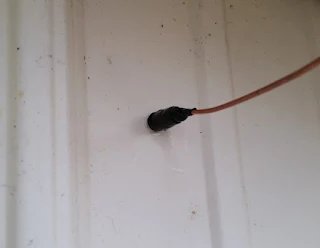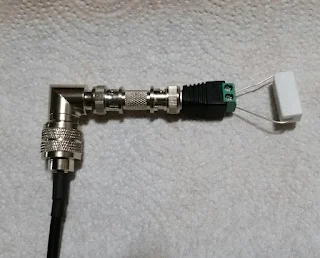A while back I wrote a post suggested that the best investments are to find projects that are languishing on the five-yard-line and to punch them into the end-zone.
This post is about one of my languishing projects. Perhaps you can relate. Maybe you will see yourself in the story and it will make you smile.
I purchased an inexpensive CB transmitter eons ago. It cost $40 and is similar to the one I linked to.
I decided that a good blogger would follow his own advice. I decided it was time to drag it out of the basement and install it.
Antennas
A quick review of the internet quickly convinced me that I needed a 1/4 wave, monopole antenna with a ground-plane in an elevated location. If I did everything right and I did not get stepped on by other traffic, a ten mile range seemed within reach.
I found a location on the peak of the garage that was 14' above the ground. That is when the fun started and the dollars started flying out of my pocket. This is where I expect you readers to smile (or grimace) with understanding.
The first bite was not too bad. I purchased $60 worth of copper tubing, lumber and PVC pipe at a big-box store where I had a rebate. I spent $4 out-of-pocket. I felt pretty good about that.
Pipe was cut. Terminals were soldered onto wires. Treated lumber was deck-screwed into the structure beneath the steel-siding of the garage. I was getting close. I just knew it.
Then I did the single, smartest thing of the whole project. I asked Old-NFO if he could provide guidance. He politely declined but then introduced me to Dr Jim, the owner of Every Blade of Grass blog. Dr Jim took me firmly in hand and tried to keep me from making too many mistakes. That was back on August 11.
I think Dr Jim underestimated my ability to make new and novel forays into stupid-land. Old NFO has known me long enough to not underestimate me that way.
Let's see, where were we...$40 transmitter, $60 for the antenna...oh, yeah...Dr Jim advised that I buy a $100 coax cable to connect the two. Do you see a trend here?
Well, since I was paying him the big-bucks for his advice I would be stupid to ignore it. I bought the cable.
Then I needed a way to convert from a PL-259 male to a twisted pair. That entailed ordering a PL-259 female-to-BNC male and a BNC female-female and a BNC male-to-twisted pair. Every arcane piece came in bags of ten, cost $12 and $6 shipping.
Dr Jim also advised loading the various connectors with dielectric grease to exclude moisture and delay corrosion. Corrosion between contacting surfaces is the bane of reliable operation. He also advised Scotch 33+ electrical tape and silicon self-sealing tape to seal out the weather. Another expert advised something similar. A tube of dielectric grease (from the local auto parts store), 33+ and silicon, self-sealing tape showed up on the doorstep in due time.
Dang! A power supply! How could I have overlooked the need for a 12V power supply? A crappy throw-away is $10 and a good one is $30... Plus $7 delivery
Then I needed an SWR meter ($30). Then I needed another short length of coax to hook the SWR meter to the transmitter since the 50' cable had already been run and the tinker-toyed connectors sealed up.
Then I needed a "dummy-load" calibration tool for the SWR meter to ensure that the readings were not fictitious. Oh, and I needed yet another short length of coax to go from the SWR meter to the dummy-load.
I chose to use a 100 Ohm resister in the calibration tool since a Standing Wave Ratio of 2.0 is often considered the threshold of usability. CBs are designed around an antenna system impedance that is the equivalent of 52 Ohms.
Every new thing that I "needed" involved finding it on-line, ordering it and then waiting for it to show up on my door-step. Most days I was waiting at the mail-box like a puppy-dog waiting for his master to come home after school.
The only thing I purchased locally were a couple of 100 Ohm resistors to cobble together the dummy-load calibration tool. Fortunately the various connectors were almost as cheap to buy ten-of so I had extras of those to make the dummy load tool.
Once I finally had all of the pieces-parts and Dr. Jim had hammered enough know-how into my head, it took about 45 minutes to dial the antenna in from a Standing Wave Ratio of 3.0 down to 1.5.
 |
| There you go. A "ground" wire that shouldn't be grounded. |
I had two issues that made up the majority of my problem. One wire of my ground-plane was in hard, metal-on-metal contact with the raw steel edge of the hole I drilled through the siding of my pole building.
I also had issues in the routing of my coax. I ran it parallel with the other utility feeds into the house and that proved to be a problem. The black-iron pipe that brought LP into the house was an inductive load for the coax running in close proximity to it.
In fact, the coax did not even like to be draped along the steel curtain rod inside the house.
A Standing Wave Ratio of 1.5 is nothing to brag about but it means that about 2/3s of the power the transmitter is trying to pump into the antenna is being converted into radio waves. That is enough to be functional and not damage the transmitter.
I want to give Dr Jim a huge shout-out. I peppered him with out-of-left-field questions. No matter how arcane or convoluted the question, he fielded them with patience and aplomb. Dr Jim is the very definition of a classy gentlemen.
Thanks Dr Jim!!!
***Added later*** The total cost of the project was approximately what I spend every month for cellphone service. A number can look scary-large until you find a meaningful basis-of-comparison. For the cost of one month's communication, I now have a second layer of redundancy for command-and-control.




I'm sure glad that I have no idea what you are talking about so I will not be tempted to take that road. ---ken
ReplyDeleteIf it is any consolation, I only half understand what I wrote. Mostly I was parroting what the smart kids were saying.
DeleteThe main point is that I can follow step-by-step directions.
-I got where I needed to be.
-I am (barely) smart enough to stop picking at the scab when I am where I need to be.
Doing it right the first time is rarely simple, easy, or cheap. Well done. (What I know about commo can be counted on the thumbs of one hand).
ReplyDeleteHave you tried contacting anyone yet?
ReplyDeleteYup. No joy yet. Not much traffic out this way.
DeleteAnd THIS is why I sent you to Jim! :-) I 'knew' you would go down the rathole on this, and I've been out of that for...many years. Glad you're up and running, and no, it's NOT cheap, but having a backup IS a good thing!
ReplyDeleteI am very grateful that you did.
DeleteThe smaller RF projects are often more challenging than the big commercial broadcast projects (speaking from experience). The efficiencies at low power are much more critical. Plus the budgeting is often more critical for the small projects. I took the lazy way out and use a dipole for both 10 & 11 (CB) meters with an antenna tuner. Not quite as efficient, but not my only backup communications either.
ReplyDeleteI'm smiling. I do several kinds of radio, including CB, and I've went through the same learning curve.
ReplyDeleteNow, can I interest you in a ham ticket?
Are you raffling off a ham? It is a little early for Christmas.
DeleteHonestly, I need to do some budget repair first. Then I have some other projects that I need to punch into the end-zone.
Looks good! The only thing is that you used a wire-wound resistor for your dummy load. You need a non-inductive resistor for that, like a Carbon Composition resistor.
ReplyDeleteI wouldn't worry too much about the radial going through the metal siding too much. Since they're at 90* to each other, they shouldn't interact much.
Parts ordered.
DeleteIf your rig is to be for after catastrophic event and that event is a EMP burst then you would find that radio useless. you could use a Faraday cage as simple as a ammo can with a grounded door hinge and box grounded to a earth ground such as a buried water pipe, ground rod, etc. Also speaking of EMP lighting also causes a problem my 'elmers' taught me to only hook up the transceiver when in use and disconnect when comm is finished. What they didn't tell me and I learned on my own, was why every time i saw a lighting flash close by I would hear electrical snap just before the lighting crash. What i found was the disconnected pl259 was acting like a spark plug. So then i started grounding that. This is Bob from Baton Rouge area just now crawling out of IDA storm.
ReplyDeletechannel 19 should be the most fertile field. I recall going to a Radio Club meeting where we announce what we have done in radio during the previous month. Mine was to hold up a bag that held $175 worth of radio parts but no radio. They all laughed. Stay away from HRO if you want to keep you wallet. Roger
ReplyDelete